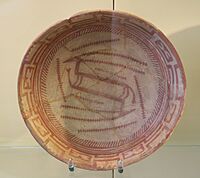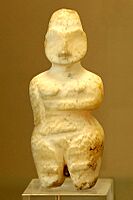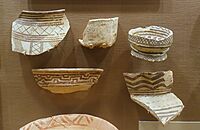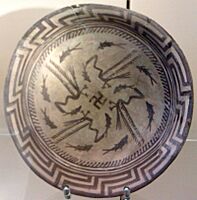Samarra culture facts for kids
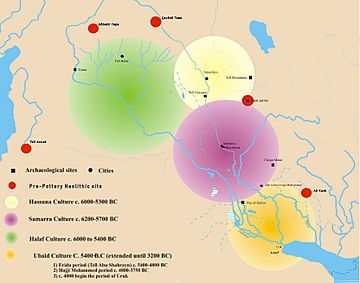 Samarra culture (in violet ), next to Halaf, Hassuna and Ubaid cultures. |
|
| Geographical range | Mesopotamia |
|---|---|
| Period | Neolithic |
| Dates | c. 5500 – c. 4800 BCE |
| Type site | Samarra |
| Major sites | Tell Shemshara, Tell es-Sawwan |
| Preceded by | Pre-Pottery Neolithic B, Halaf culture, Hassuna culture, Halaf-Ubaid Transitional period |
| Followed by | Ubaid period |
The Samarra culture was an ancient group of people who lived in northern Mesopotamia (modern-day Iraq). They were part of the Neolithic period, which means they were among the first people to farm and live in settled villages. This culture existed roughly between 5500 and 4800 BCE.
The Samarra culture partly existed at the same time as the Hassuna culture and the early Ubaid period. Archaeologists first learned about the Samarra culture from discoveries made by Ernst Herzfeld at a place called Samarra.
Life in the Samarra Culture
People of the Samarra culture were very skilled farmers. At a site called Tell es-Sawwan, archaeologists found proof that they used irrigation to water their crops. This helped them grow plants like flax, which could be used to make cloth.
Using irrigation meant they had a successful and settled way of life. It also shows they had a well-organized community. Everyone likely worked together to manage the water and farm the land.
Amazing Samarra Pottery
The Samarra culture is most famous for its beautiful pottery, often called Samarra ware. This pottery was made with great care and skill.
The designs on the pottery are very special. They often feature stylish animals, like birds, and cool geometric patterns. These designs were usually painted on a dark background.
This type of pottery was very popular and was traded widely across the Ancient Near East. It was one of the first pottery styles that became well-known and similar in many different places. The Samarra culture's pottery style helped lead to the later Ubaid period culture in Mesopotamia.
Where Did They Live?
Archaeologists have found evidence of the Samarra culture at several important sites. Besides Samarra itself, these include Tell Shemshara, Tell es-Sawwan, and Yarim Tepe.
Similar pottery and cultural influences have also been found in parts of Syria. These sites include Tell Sabi Abyad, Tell Chagar Bazar, Tell Boueid II, and Tell Halula. This suggests that the Samarra culture had a wide reach and influenced many nearby communities.
See also
- Desert Kites
- Hassuna culture
- History of Mesopotamia


